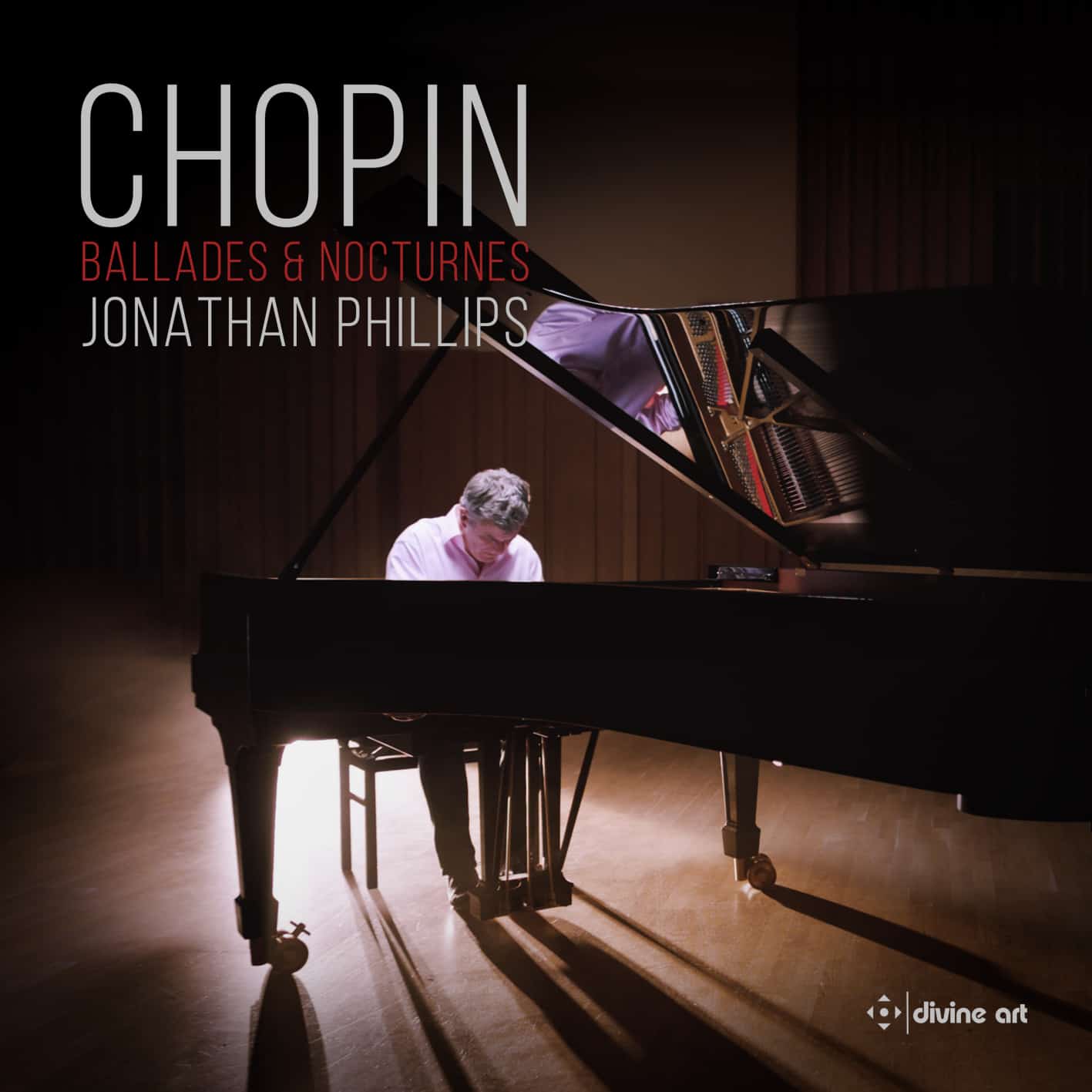Atlanta Audio Club
Following up on the success of his all-Bach album “Tranquility,” which I was pleased to review in my column this past September, British pianist Jonathan Phillips returns to his pursuit of music giving rise to feelings of centeredness and well-being in “Chopin,” his latest release on the Divine Art label. His choice of this composer as the subject of the follow-up to his earlier success is not accidental, as Chopin is said to have been influenced by Bach in his own development, incorporating the earlier master’s harmony and counterpoint so subtly and to such good advantage that it doesn’t stick out. The natruralness and sheer poetic beauty of Chopin’s mature style reveals itself perhaps most clearly in his four Ballades which would have secured his place in the musical pantheon had he written nothing else. Ballade No. 1 in G minor, Op. 23 is given a solemn, slow opening, gradually becoming more robust as it develops in the thoughtful interpretation we are given here. The sinister ending that should never fail to given the impression of falling icicles comes across very well here. Ballade No. 2 in F major, Op. 38 follows up the very slow, introspective mood of its opening with some stirring passagework before returning to its previous mood. Phillips employs a judicious amount of legato in this ballade, just enough to be very effective.
Ballade No. 3 in A-flat major, Op. 47 is possibly the best-known of the four because its theme provided the melody for a well- remembered American pop song of yesteryear, “I’m Always Chasing Rainbows.” Phillips is careful not to apply too much legato here, but just enough to give plausibility to the rippling measures at the very end. And Ballade No. 4 in F minor, Op. 52, opening in a bewitching “once upon a time” mood, gradually elvolves in tone and form in Phillips’ beautiful interpretation so that the ending, though quickened, does not seen excessively so. The pianist handles Chopin’s strong cadences so expertly that the quiet, poetic element is allowed to make its wonted effect, causing us to wonder which element will prevail in the end?
The all-Chopin program concludes with five dreamy Nocturnes. This Chopin genre is treasured by many people as promoting peace, serenity, and centeredness in the listener, although not all of his nocturnes fit that description. Nocturne in E flat major Op.9 No.2, with its aura of breathless charm and enchantment, certainly does. On the other hand, the Nocturne in B major, Op. 62, No. 1 is more venturous, with a notable mood of urgency, before subsiding into a quiet ending. The Nocturne in B major, Op. 32, No. 1, enchants us with widely spaced bell-like sounds, while the F minor, Op. 55, No. 1 seems evocative of love, and the beautifully harmonized F Minor, Op. 55, No. 1 has the feeling of a promenade. Phillips’ sensitive artistry brings out the best in all five pieces.
@divineartrecordingsgroup
A First Inversion Company
Registered Office:
176-178 Pontefract Road, Cudworth, Barnsley S72 8BE
+44 1226 596703
Fort Worth, TX 76110
+1.682.233.4978










![Listen to the full suite of Marcel Dupré’s Variations Sur un Noël, Op. 20 from Alexander Ffinch’s #Expectations release today! listn.fm/expectations [in bio]](https://scontent-dfw5-1.cdninstagram.com/v/t51.71878-15/588904367_2327488161082898_8709236950834211856_n.jpg?stp=dst-jpg_e35_tt6&_nc_cat=105&ccb=7-5&_nc_sid=18de74&efg=eyJlZmdfdGFnIjoiQ0xJUFMuYmVzdF9pbWFnZV91cmxnZW4uQzMifQ%3D%3D&_nc_ohc=H8WFKm530VcQ7kNvwFTB96K&_nc_oc=Adm7UvXUkaxlfggqdb0gaW3r0IXCUz8AWWru_2Jpcsfi9ZpVP8NmQPWfxkgldDs67lI&_nc_zt=23&_nc_ht=scontent-dfw5-1.cdninstagram.com&edm=ANo9K5cEAAAA&_nc_gid=qo_K9UMz21c8Ybyb93iVkA&oh=00_AflVLZLvMjRbOUGwb3QtBgRIh3SAbxYa6IksPi_QDP2LpA&oe=6955D9AA)

![“the ‘Manteca’ Paraphrase – a rare foray into the two-piano medium but here played double-tracked – exudes a panache of which Dizzy Gillespie would surely have approved.… [a] recital well worth investigating.” —Gramophone Magazine with high praise for Ophelia Gordon's debut release, Kapustin: Between the Lines!](https://scontent-dfw5-3.cdninstagram.com/v/t51.82787-15/598796470_18303255136283342_540941604740887837_n.jpg?stp=dst-jpg_e35_tt6&_nc_cat=108&ccb=7-5&_nc_sid=18de74&efg=eyJlZmdfdGFnIjoiRkVFRC5iZXN0X2ltYWdlX3VybGdlbi5DMyJ9&_nc_ohc=IC4zZ7tcpb8Q7kNvwHZb7_Y&_nc_oc=AdlV2T2HQxLQmm1ZK3dDQiWtnzNgrVCeDisi9DBfAy6VvWJgobJUs6DoeEe3X6co88c&_nc_zt=23&_nc_ht=scontent-dfw5-3.cdninstagram.com&edm=ANo9K5cEAAAA&_nc_gid=qo_K9UMz21c8Ybyb93iVkA&oh=00_Afl-ZoKW43dQPI9OnN5W1r_FUajSbENOeIyI8_CIwjouqA&oe=6955EC44)